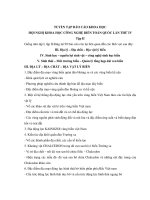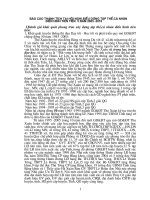Báo cáo của Hội nghị khoa học “Bệnh hô hấp”
Bạn đang xem bản rút gọn của tài liệu. Xem và tải ngay bản đầy đủ của tài liệu tại đây (1.42 MB, 41 trang )
<span class='text_page_counter'>(1)</span><div class='page_container' data-page=1>
<b>COPD Assessment and Treatment </b>
<b>Strategies Based on the Latest </b>
<b>GOLD Guidelines</b>
<b>Steven E. Lommatzsch, M.D.</b>
<b>Pulmonary and Critical Care</b>
</div>
<span class='text_page_counter'>(2)</span><div class='page_container' data-page=2>
Learning Objectives
Describe the GOLD recommendations for the
combined assessment of COPD
Differentiate high risk COPD patients from low risk
patients in your practice
</div>
<span class='text_page_counter'>(3)</span><div class='page_container' data-page=3>
Background
In 1998 the Global Initiative for Chronic
Obstructive Lung Disease (GOLD) was
implemented to increase diagnosis and
improve management and prevention of
COPD
<sub>In 2001 GOLD released </sub><i><sub>‘Global Strategy </sub></i>
<i>for the Diagnosis, Management and </i>
<i>Prevention of COPD’</i>
Various updates have taken into account
new concepts and emerging research
</div>
<span class='text_page_counter'>(4)</span><div class='page_container' data-page=4></div>
<span class='text_page_counter'>(5)</span><div class='page_container' data-page=5>
How to Diagnose COPD
Symptoms
Shortness of breath
Chronic cough
Chronic sputum
History of exposure to risk factors
Tobacco smoke
Home cooking/biomass fuels
</div>
<span class='text_page_counter'>(6)</span><div class='page_container' data-page=6>
Perform Spirometry
The diagnosis of COPD relies on the demonstration of
airflow limitation with post bronchodilator FEV<sub>1</sub>/FVC
< 0.7
FEV<sub>1 </sub>= Forced expiratory volume in 1st second
GOLD severity based on FEV1
GOLD 1 Mild FEV1 ≥ 80% predicted
</div>
<span class='text_page_counter'>(7)</span><div class='page_container' data-page=7>
Is FEV
<sub>1</sub>the Best Marker for Severity
Assessment of COPD?
Jones et al. COPD 2009;6:59-63
<b>Poor Health</b>
</div>
<span class='text_page_counter'>(8)</span><div class='page_container' data-page=8>
Combined Assessment of COPD
Severity
Assessment of airflow limitation
<sub>Assessment of symptoms</sub>
</div>
<span class='text_page_counter'>(9)</span><div class='page_container' data-page=9>
<b>Combined COPD Assessment*</b>
<b>Risk</b>
<b>(GO</b>
<b>LD</b>
<b> S</b>
<b>ta</b>
<b>ge </b>
<b>of </b>
<b>A</b>
<b>irflow</b>
<b> Li</b>
<b>mi</b>
<b>ta</b>
<b>tion)</b>
<b>Risk</b>
<b>(Exa</b>
<b>c</b>
<b>erba</b>
<b>tion </b>
<b>hi</b>
<b>st</b>
<b>ory</b>
<b>)</b>
> 2
0-1
<b>(C)</b>
<b><sub>(D)</sub></b>
<b>(A)</b>
<b>(B)</b>
<b>mMRC 0-1</b>
<b>CAT < 10 </b>
4
3
2
1
<b>mMRC > 2</b>
<b>CAT > 10 </b>
*Choose the highest risk according to GOLD stage or exacerbation history
<b>___________Symptoms________</b>
50<FEV1<80
30<FEV1<50
</div>
<span class='text_page_counter'>(10)</span><div class='page_container' data-page=10>
<sub>There are several validated questionnaires available to </sub>
assess symptoms
<sub>GOLD recommends:</sub>
Modified British Medical Research Council
Questionnaire (easier to use)
COPD Assessment Test (broader coverage of impact)
</div>
<span class='text_page_counter'>(11)</span><div class='page_container' data-page=11>
Assessment of Symptoms
<b>Modified British Medical Research Council Questionnaire </b>
<b>(MMRC) dyspnea score</b>
0 No shortness of breath except for strenuous exercise
1 Short of breath hurrying on level or walking up a hill
2 Have to stop when walking on level
3 Stop for breath after 100m or few minutes on level
4 Too breathless to leave the house or to perform daily
</div>
<span class='text_page_counter'>(12)</span><div class='page_container' data-page=12>
Assessment of Symptoms
<b>COPD Assessment test (CAT)</b>
<b>8 item measure of health </b>
<b>status</b>
<b>Score 0 -5 </b>
<b>Impact</b>
<b><10 – low</b>
<b>11-20 – medium</b>
<b>21-30 – high</b>
<b>31 - 40 – very high</b>
0 Cough 5
0 Phlegm 5
0 Chest tightness 5
0 Short of breath on hill or
flight of stairs
5
0 Limitation in home
activities
5
0 Confidence leaving home 5
0 Sleep 5
0 Energy 5
</div>
<span class='text_page_counter'>(13)</span><div class='page_container' data-page=13>
Assessment of Exacerbation Risk
Exacerbations increase decline in lung function,
health status and the risk of death.
<sub>Greatest risk factor for future exacerbations is a </sub>
history of previous exacerbations.
</div>
<span class='text_page_counter'>(14)</span><div class='page_container' data-page=14>
From OLD to New Classification
The old GOLD system of classification and
treatment made recommendations based only on
the severity of lung dysfunction from spirometry
(GOLD stages I – IV).
The new GOLD system of classification and
treatment is based on an integrated approach, and
considers all three: spirometry, symptoms, and
</div>
<span class='text_page_counter'>(15)</span><div class='page_container' data-page=15>
Example: Combined COPD Assessment*
<b>Risk</b>
<b>(GO</b>
<b>LD</b>
<b> S</b>
<b>ta</b>
<b>ge </b>
<b>of </b>
<b>A</b>
<b>irflow</b>
<b> Li</b>
<b>mi</b>
<b>ta</b>
<b>tion)</b>
<b>Risk</b>
<b>(Exa</b>
<b>c</b>
<b>erba</b>
<b>tion </b>
<b>hi</b>
<b>st</b>
<b>ory</b>
<b>)</b>
> 2
0-1
<b>(C)</b>
<b><sub>(D)</sub></b>
<b>(A)</b>
<b>(B)</b>
<b>mMRC 0-1</b>
<b>CAT < 10 </b>
4
3
2
1
<b>mMRC > 2</b>
<b>CAT > 10 </b>
*Choose the highest risk according to GOLD stage or exacerbation history
<b>___________Symptoms________</b>
50<FEV1<80
30<FEV1<50
</div>
<span class='text_page_counter'>(16)</span><div class='page_container' data-page=16></div>
<span class='text_page_counter'>(17)</span><div class='page_container' data-page=17>
<b>www.goldcopd.org</b>
• Relieve symptoms
• Prevent disease progression
• Improve exercise tolerance
• Improve health status
• Prevent and treat complications
• Prevent and treat exacerbations
• Reduce mortality
</div>
<span class='text_page_counter'>(18)</span><div class='page_container' data-page=18>
<b>Treatment of Stable COPD</b>
1 - Smoking Cessation
2 - Pharmacologic Treatment
3 - Pulmonary Rehabilitation
4 - Oxygen Therapy
</div>
<span class='text_page_counter'>(19)</span><div class='page_container' data-page=19>
<b>1 - Smoking Cessation</b>
- Smoking cessation is a key
component to preserving lung
function, and no other therapy
impacts the natural disease
progression more.
- The most proven therapy for
smoking cessation is a
multifaceted approach of support
networks, nicotine replacement,
and agents like bupropion and
varenicline.
</div>
<span class='text_page_counter'>(20)</span><div class='page_container' data-page=20>
<i>Adapted from Fletcher CM, Peto R. Br Med J. 1977;1:1645</i>
0
20
Age (years)
Death
Disability
Symptoms
Not Susceptible
Susceptible
Smokers
Stopped smoking
at 45 (mild COPD)
Stopped smoking
at 65 (severe COPD)
30 40 50 60 70 80 90
20
</div>
<span class='text_page_counter'>(21)</span><div class='page_container' data-page=21>
<b>Smoking Cessation Therapy</b>
<b>Varenicline 2mg/day</b>
B<b>uproprion SR</b>
<b>NRT Nasal Spray</b>
<b>NRT Patch</b>
<b>NRT Gum</b>
<b>NRT Patch + Buproprion SR</b>
<b>NRT Patch +Spray</b>
NRT – nicotine replacement therapy
<b>USPHS 2008 meta-analysis </b>
<b>33.2%</b>
<b>24.2%</b>
<b>26.7%</b>
<b>23.4%</b>
<b>19.0%</b>
<b>28.9%</b>
<b>25.8%</b>
</div>
<span class='text_page_counter'>(22)</span><div class='page_container' data-page=22>
<b>2 - Pharmacologic Treatment</b>
</div>
<span class='text_page_counter'>(23)</span><div class='page_container' data-page=23>
<b>2 - Pharmacologic Treatment</b>
- The GOLD recommendations are guided
by assessing lung function, symptoms,
and exacerbations.
- Appropriate therapy is dependent upon
each patient’s needs and responses to
</div>
<span class='text_page_counter'>(24)</span><div class='page_container' data-page=24>
<b>Treatment based on Combined COPD </b>
<b>Assessment*</b>
<b>Ris</b>
<b>k </b>
<b>(GO</b>
<b>LD</b>
<b> Classific</b>
<b>at</b>
<b>ion</b>
<b> of </b>
<b>A</b>
<b>irflow</b>
<b>Lim</b>
<b>ita</b>
<b>tion)</b>
<b>Risk</b>
<b>(Exa</b>
<b>ce</b>
<b>rbat</b>
<b>ion</b>
<b>history</b>
<b>)</b>
> 2
0-1
<b>(C)</b>
<b>(D)</b>
<b>(A)</b>
<b><sub>(B)</sub></b>
<b>mMRC 0-1</b>
<b>CAT < 10 </b>
4
3
2
1
<b>mMRC > 2</b>
<b>CAT > 10 </b>
*Choose the highest risk according to GOLD stage or exacerbation history
SAMA <i>prn</i>
<i>or</i>
SABA prn
<b>___________Symptoms________</b>
50<FEV1<80
30<FEV1<50
</div>
<span class='text_page_counter'>(25)</span><div class='page_container' data-page=25>
<b>Category A : Pharmacologic Treatment</b>
- Short acting bronchodilators are integral to
management of symptoms.
- Short acting agents alone are not
recommended for patients with more
sustained daily symptoms or experiencing
more frequent exacerbations.
- Combination therapy results in synergistic
effects<b>.</b>
</div>
<span class='text_page_counter'>(26)</span><div class='page_container' data-page=26>
<b>Treatment based on Combined COPD </b>
<b>Assessment*</b>
<b>Ris</b>
<b>k </b>
<b>(GO</b>
<b>LD</b>
<b> Classific</b>
<b>at</b>
<b>ion</b>
<b> of </b>
<b>A</b>
<b>irflow</b>
<b>Lim</b>
<b>ita</b>
<b>tion)</b>
<b>Risk</b>
<b>(Exa</b>
<b>ce</b>
<b>rbat</b>
<b>ion</b>
<b>history</b>
<b>)</b>
> 2
0-1
<b>(C)</b>
<b>(D)</b>
<b>(A)</b>
<b><sub>(B)</sub></b>
<b>mMRC 0-1</b>
<b>CAT < 10 </b>
4
3
2
1
<b>mMRC > 2</b>
<b>CAT > 10 </b>
*Choose the highest risk according to GOLD stage or exacerbation history
SAMA <i>prn</i>
<i>or</i>
SABA prn
<b>___________Symptoms________</b>
</div>
<span class='text_page_counter'>(27)</span><div class='page_container' data-page=27>
<b>Category B : Pharmacologic Treatment</b>
- Long acting bronchodilators are
recommended for all patients with daily
symptoms.
- They are more effective for symptom relief
than short-acting bronchodilators.
</div>
<span class='text_page_counter'>(28)</span><div class='page_container' data-page=28>
<b>Treatment based on Combined COPD </b>
<b>Assessment*</b>
<b>Ris</b>
<b>k </b>
<b>(GO</b>
<b>LD</b>
<b> Classific</b>
<b>at</b>
<b>ion</b>
<b> of </b>
<b>A</b>
<b>irflow</b>
<b>Lim</b>
<b>ita</b>
<b>tion)</b>
<b>Risk</b>
<b>(Exa</b>
<b>ce</b>
<b>rbat</b>
<b>ion</b>
<b>history</b>
<b>)</b>
> 2
0-1
<b>(C)</b>
<b>(D)</b>
<b>(A)</b>
<b><sub>(B)</sub></b>
<b>mMRC 0-1</b>
<b>CAT < 10 </b>
4
3
2
1
<b>mMRC > 2</b>
<b>CAT > 10 </b>
*Choose the highest risk according to GOLD stage or exacerbation history
SAMA <i>prn</i>
<i>or</i>
SABA prn
<b>___________Symptoms________</b>
50<FEV1<80
30<FEV1<50
FEV1>80%
FEV1<30% ICS + LABA
<i>and/or</i>
LAMA
LABA
<i>or</i>
</div>
<span class='text_page_counter'>(29)</span><div class='page_container' data-page=29>
<b>Category C & D : Pharmacologic </b>
<b>Treatment</b>
- These two groups are treated similarly
because of the increased exacerbation risk in
both. Thus, therapy attempts to decrease risk
of exacerbations.
- As the distinguishing feature between C and
D is symptoms, the chosen therapy should be
that which best relieves the patient’s
</div>
<span class='text_page_counter'>(30)</span><div class='page_container' data-page=30>
<b>Additional Choice – Medical Management</b>
<b>1 </b>- Roflumilast (phosphodiesterase-4 inhibitor) is
approved in chronic bronchitic patients with
frequent exacerbations, and an FEV1 < 50%, to
help decrease the exacerbation rates.
Lancet. 2009 Aug 29;374(9691):685-94
2 - Chronic daily Azithromycin has also been
proven to decrease exacerbation rates.
</div>
<span class='text_page_counter'>(31)</span><div class='page_container' data-page=31>
Chronic Azithromycin Therapy*
*Albert et al. N Engl J Med. 2011 Aug 25; 365:689-698
</div>
<span class='text_page_counter'>(32)</span><div class='page_container' data-page=32>
<b>3 - Pulmonary Rehabilitation</b>
- Physical therapy has been underutilized by
providers, and it is one of the most proven
interventions to help with dyspnea.
- Therapy typically consist of exercise training,
education, nutritional interventions, and
psychosocial support.
</div>
<span class='text_page_counter'>(33)</span><div class='page_container' data-page=33>
n=93
</div>
<span class='text_page_counter'>(34)</span><div class='page_container' data-page=34>
<b>4 - OxygenTherapy </b>
- Oxygen therapy is the most well established
intervention to afford greater survival to the
COPD patient.
- It is indicated once PaO2 is less than 55 mmHg,
and the goal is keep sats > 88% during rest, sleep,
and exertion.
</div>
<span class='text_page_counter'>(35)</span><div class='page_container' data-page=35>
Oxygen Improves Survival in COPD
Oxygen Improves Survival in COPD
Flenley DC. <i>Chest </i>1985:87:99.
<i>Lancet </i>1981:1:681
NOTT Trial Group. <i>Ann Intern Med </i>
1980:16936:391
<b>NOTT study:</b>
<b>COT – Continuous oxygen (17.7hr)</b>
<b>NOT – Nocturnal oxygen</b>
<b>MRC trial:</b>
<b>O2 – “nocturnal” oxygen (15hr)</b>
<b>Controls – no oxygen </b>
</div>
<span class='text_page_counter'>(36)</span><div class='page_container' data-page=36>
Mortality in subjects with:
Upper lobe disease and low
exercise capacity
1218 severe COPD patients
Assessment
– CT distribution
– Exercise performance
Randomize
– Surgery
– Medical management
Re-evaluate: 6 months, yearly
Assess
– Survival
– Exercise
Fishman A, et al. <i>N Engl J Med</i>. 2003;348:2059-2073.
Lung Volume Reduction Surgery in Emphysema:
NETT trial
</div>
<span class='text_page_counter'>(37)</span><div class='page_container' data-page=37>
- The National Emphysema Treatment Trial (NETT )
- Volume Reduction Surgery (LVRS) with upper lobe
predominate emphysema, FEV1 < 45% of predicted, gas
trapping, no significant pulmonary hypertension, and
DLCO and FEV1 values of greater than 20%.
- LVRS improved functional status, physiologic parameters,
and quality of life as compared to the medically managed
group.
- Lung Volume Reduction Surgery was shown to offer
substantial survival to those patients who had low exercise
tolerance post rehabilitation.
</div>
<span class='text_page_counter'>(38)</span><div class='page_container' data-page=38>
- Lung transplantation is a consideration for those
patients with considerable disability despite maximal
medical therapy.
- Factors Include:
Age < 65 years No cancer in the last 5 years
No Hepatitis B, C, HIV No tobacco in last 6 months
No severe osteoporosis No substances abuse
Reliable support network No major organ dysfunction
BMI in range (<30) No advanced coronary
disease
</div>
<span class='text_page_counter'>(39)</span><div class='page_container' data-page=39>
<b>Treatment of Comorbidities</b>
- It is important to remember these disorders and
treat accordingly.
- Cardiovascular disease (most common)
- Diabetes (especially with frequent steroid use)
- Lung cancer (close to 10-fold greater in subjects
with severe COPD)
- Osteoporosis
</div>
<span class='text_page_counter'>(40)</span><div class='page_container' data-page=40>
<b>- Brief Summary of Medical </b>
Management-- Assess symptoms, spirometry, and exacerbation risk to
characterize each patient and individualize therapy.
- Use frequency of exacerbations (> 2/yr) and/or an FEV1 <
50% of predicted to indicate higher risk patients that
should be on combination inhaled steroids/long acting b
-agonist and/or long acting antimuscarinic, or a
combination.
</div>
<span class='text_page_counter'>(41)</span><div class='page_container' data-page=41></div>
<!--links-->









